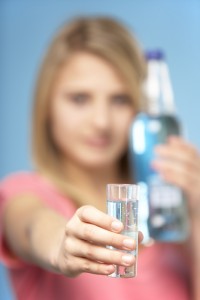Underage drinking—when an individual below the age of 21 consumes alcohol—continues to be a problem in the U.S.
According to the National Institute on Alcohol Abuse and Alcoholism, 72 percent of teenagers have consumed alcohol by the time of their high school graduation; 37 percent began drinking by 8th grade. By the age of 15, approximately half of all teenagers have consumed at least one drink.
In addition to the problem of when teens start drinking is the problem of how much. Although the majority of teens drink less frequently than adults, they are more likely to drink heavily when they do. The average amount of alcohol consumed by a teen per drinking occasion is five drinks, which falls under the category of binge drinking—defined as consuming five or more drinks in a single occasion.
Why do teens drink?
There are many reasons. Some teens drink to try to escape problems with friends, parents or school. Some drink because they like to take risks and want to feel the “rush” of doing something they’re not supposed to do. Some drink out of curiosity, or because they think it will help them feel grown-up. Many, of course, drink due to peer pressure.
Also, there is misperception. Young people generally believe more people their age drink alcohol than actually do, or that “all the cool kids drink.” But not all teens drink, and many of the “cool kids” are among those who don’t. If one-half of all 15-year- olds have consumed alcohol, that means half of all 15-year-olds have not.
What are the consequences?
Teen drinking poses a wide variety of risks, including:
Impaired judgment—Teens who drink make poor decisions, such as drinking and driving, using violence, and sexual activity.
Increased risk of assault—Youth who drink are more likely to be victims or perpetrators of physical or sexual assault.
Impact on brain development—The human brain continues to develop up to about the age of 25. Underage drinking can hurt the developing brain, creating problems in how it works.—In 2008, more than 190,000 youth went to a hospital emergency room for alcohol-related injuries—an average of 520 ER visits per day.
Injury—In 2008, more than 190,000 youth went to a hospital emergency room for alcohol-related injuries—an average of 520 ER visits per day.
Death—Between 4,000 and 5,000 underage drinkers die each year from alcohol-related car crashes, homicides, suicides, alcohol poisoning and accidents (e.g., falls, drownings, etc).
What can parents do?
One of the best ways to prevent or curb teen drinking is to talk with your child. Begin having conversations about alcohol use when they are young, and be consistent in what you communicate.
Parents should also be good role models. If you drink alcohol responsibly, you show your children that alcohol use need not be dangerous. Responsible alcohol use includes not driving following drinking, not drinking in excess, and not drinking to deal with stress.
Research shows that children whose parents are actively involved in their lives are less likely to drink alcohol.
Sources/Helpful Resources:
http://pubs.niaaa.nih.gov/publications/UnderageDrinking/Underage_Fact.pdf
http://www.cdc.gov/alcohol/fact-sheets/minimum-legal-drinking-age.htm
http://www.samhsa.gov/programs-campaigns/talk-they-hear-you/parent-resources/five-conversation-goals
http://www.samhsa.gov/underage-drinking/parent-resources/why-your-child-might-start-drinking
Submitted by UB Research Institute on Addictions. Learn more at 716-887-3365.












